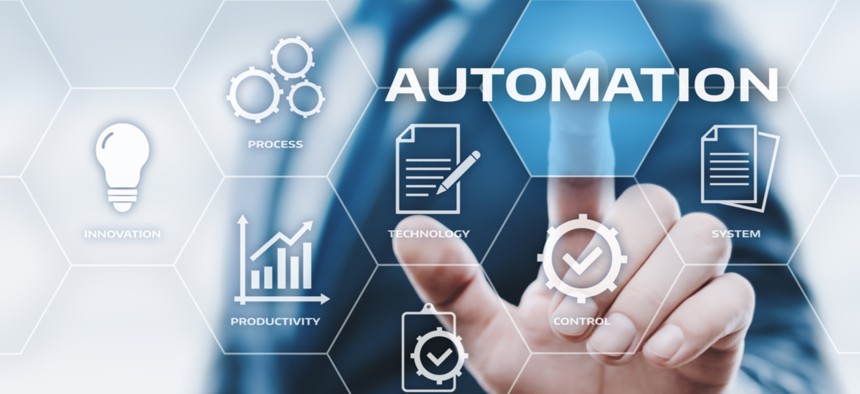Without Automation, There is No Federal IT Modernization

Alexander Supertramp/Shutterstock.com
But making automation a reality will be a challenge.
Bob Osborn is the federal chief technology officer at ServiceNow.
Of the executive orders signed during President Donald Trump’s first six months, the most sweeping came in March and called for a reorganization of the executive branch.
The order came in tandem with the president’s budget blueprint that outlined a proposal “to eliminate funding for programs that are unnecessary, outdated, or not working.” It has been clear since the start of the Trump administration that increasing government efficiency is a top priority. This month, agencies have delivered their first drafts of the required reform plans and now it’s time for agencies to begin turning these plans into action.
» Get the best federal technology news and ideas delivered right to your inbox. Sign up here.
These initial plans are critical for setting into motion the modernization efforts across the federal government. However, I do expect that agencies will have a tempered response, at least initially, as they await developments on funding. The Modernizing Government Technology Act has passed through the House but is waiting for the House and Senate conference committee to hammer out differences in the defense authorization bill, where it's tucked into the Senate version. And Congress' budget talks could further impact these reorganization plans.
Regardless of how the funding scenarios plays out, the most critical aspect of these organization plans will focus on improving the underlying business processes by leveraging leading-edge technology. When it comes to technology, nothing will help the federal government more than automation. But making automation a reality will be a challenge.
The Complex Barriers to Federal Automation
IT modernization is certainly not a new theme, as President Barack Obama’s administration began to push forth several initiatives to encourage modernization, particularly during his second term. Still, the barriers to modernization in the federal government have never been more complex.
For instance, many manual processes remain, especially when it comes to processes that cut across multiple departments. There is a need to initiate agencywide approaches to service delivery but the challenge is developing an automated process that includes data stored in legacy systems. The federal government continues to spend nearly 80 percent of its IT spending on legacy systems, an amount that severely limits its ability to shift to new technology.
When we look at automated processes, there are several aspects that seem to be ripe for change. A great example is the onboarding of federal personnel, which is common in the commercial space. For federal agencies, onboarding personnel spans human resources, financial and IT infrastructure—and these processes are currently disconnected. Because they are disconnected, the onboarding process is forced to remain a manual process.
Cloud Provides the Path to Automation
As the federal government looks to bring these disconnected silos of information and IT systems together, the future is in the cloud. It is critical that federal agencies move to cloud because it is the foundation of providing modern, consumer-like services to citizens.
In our daily lives, we have chosen a platform—either a smartphone or tablet—that runs applications that instantly provide information to us that allows us to make informed decisions. If you’re leaving your office in Tysons and heading into D.C. for a meeting, the first thing you do is check Waze or Google Maps to figure out, instantly, which route is best. This is the expectation of today’s workforce: We should receive the information we need to make a decision in an instant.
To deliver this type of modern user experience for federal agencies, there needs to be a multi-instance enterprise cloud that allows systems to pull information from multiple data sources. We simply don’t have that in most federal agencies today, and that leads to agencies taking on manual process and making decisions based on stale data.
In my opinion, this is an archaic way to do business and we must begin to look at federal agencies that same way we would look at a commercial company. The expectation must be raised and agencies can achieve a modern user experience with an automated process and access to real-time data for better decision-making.
Best Practices for Agencies Moving Forward
The most important advice I give to agency leaders is to encourage them to do their homework. While cloud is certainly the future, not all clouds are created equal. You need to make sure that the platform you have chosen is the one that will provide you with exactly what your agency needs.
Secondly, agencies must become comfortable with starting small and growing. There is an inherent reluctance from agency leaders to begin small because there is a concern that it would be difficult to scale or that early setbacks can hinder the effort.
Instead, the complete opposite is true. By starting small—in one business area or department—you can discover what works and what does not work, and then grow the usage of cloud throughout the agency, adding on different areas and departments. It’s the same as when you sign up for DirecTV: You can begin with a basic package to ensure you like the service and can continue to add on channels to reach the desired result.
Today, CIOs struggle with keeping up with new technologies. The cloud platform approach provides constant upgrades and new technology as new functionality and new apps are always added and subscriptions are always modernized. Instead of upgrades being a big issue, they become non-events. Agencies can keep up with modern technology and lower cybersecurity risk all at a lower cost by relying on cloud.





